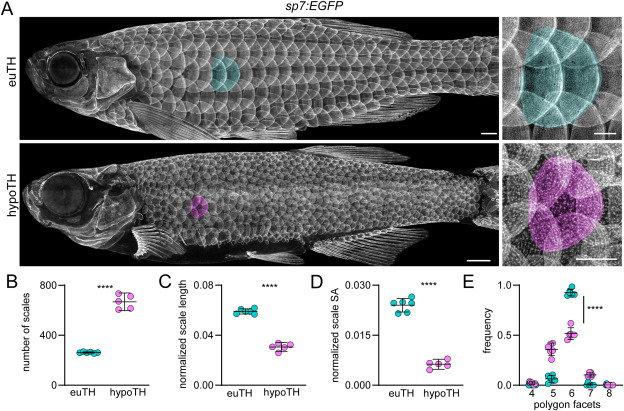Fig. 1 Thyroid hormone is necessary for normal squamation. (A) Dermal skeleton of eu-thyroid controls (euTH, n ?= ?6) and hypothyroid (hypoTH, n ?= ?5) fish visualized with sp7:EGFP. Representative scales false colored in green (euTH) and magenta (hypoTH). (B) hypoTH fish developed more numerous scales than euTH controls (t9 ?= ?17.55, p ?< ?0.0001). (C) hypoTH scales were shorter relative to fish body length, when scales were measured from their anterior to posterior margins and these lengths expressed as a proportion of the fish standard length (t9 ?= ?19.22, p ?< ?0.0001; n ?= ?6 euTH, 5 hypoTH). (D) hypoTH scales occupied a significantly smaller portion of the body surface area (SA) compared with euTH controls (t9 ?= ?17.58, p ?< ?0.0001). (E) hypoTH squamation was disorderly compared to euTH controls, quantified by Voronoi tessellation analysis of pattern hexagonality. Each bin, 4?8, shows the proportion of scales bounded by that number of immediate neighbors. The frequency of scales bounded by the modal number of 6 neighbors in euTH animals vs other numbers of neighbors differed between euTH and hypoTH individuals (?2 ?= ?310.72, d.f. ?= ?1, p ?< ?0.0001, N ?= ?396 scales of 6 euTH individuals and N ?= ?1262 scales of 5 hypoTH individuals; ????, t9 ?= ?11.64, p ?< ?0.0001). Proportions were arcsin-transformed for analysis (Sokal and Rohlf, 1981). Bars in plots are means ?± ?95% CI. Scale bars, (A) 1 ?mm.
Reprinted from Developmental Biology, 477, Aman, A.J., Kim, M., Saunders, L.M., Parichy, D.M., Thyroid hormone regulates abrupt skin morphogenesis during zebrafish postembryonic development, 205-218, Copyright (2021) with permission from Elsevier. Full text @ Dev. Biol.

